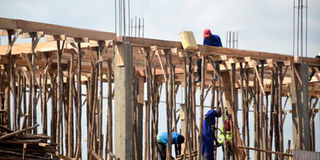Prime
Why do so many good construction projects fail?

A building under construction. PHOTO BY EDGAR BATTE
What you need to know:
- Most neighbourhoods have those houses that began with so much promise only to stop midway. What was once someone’s dream becomes a neighbourhood eyesore and a source of cautionary tales.
Each year, people are forced to abandon what originally seemed like well-planned, well-organised construction projects, destined for success.
A number of professionals who work in this industry point out significant recurring problems that have led to project failures.
While substandard material and a breakdown in the supply chain are attributed as the main reason for halting or abandoning the project altogether, changes in regulatory processes and over-exposure to unfavourable weather conditions cause severe financial losses.
Force majeure
There is this huge double storeyed house in my childhood neighbourhood. The house now falling to pieces from years of neglect never got the chance to reach completion. The story goes that it belonged to a once very powerful person in one of the past governments.
When governments changed as they often did in those turbulent days of our history, the once big man had no where else to live since he was evicted from his government residence, so he moved in with his extended family. He did not even have any savings left over to do some basic finishings such as windows and doors. So they just put cardboard in the window frames. The house has stayed incomplete for more than three decades.
This, according to Ronald Atwiine, a construction engineer, is a representation of a number of constructions that never reached completion because their owner never got the chance to because they lost their fortune, position or God forbid their lives.
While these are unpredictable and uncontrollable forces of nature some buildings project never get to reach completion because of a number of other reasons.
Unprepared workforce
Man is given to ostentation and fanciful grandeur, look at how much the fashion industry makes every year by selling to us the idea that what matters is what is trending. It is not any different when it comes to our houses, we want ours to be the ones that stand out on the hill.
We come up with designs complicated and out there. When we are lucky and they work out they become a show of what the human can achieve, think of the Taj Mahal or the pyramids in Egypt.
To complicate matters, there may be an insufficiency in either human or technical resources needed to turn these dreams into reality.
Why construction projects fail spectacularly here is because the existing workforce is assigned workloads they are unprepared for; or a productivity lapse ensues in the time for newly hired workers to gain total mastery over the work under consideration. Without the necessary resource support, we are left with a pile of bricks and failed dreams.
Wishful thinking
Atwiine, who has had the opportunity to work on multiple projects, notes that the biggest issue is client behaviour and attitude. He relates that a few years ago, he had four projects running, of which only one reached completion.
“One of the issues I have found frustrating is the mismatch between clients’ dreams and their reality. Many people dream of building double storeyed houses yet what they can actually afford comfortably are medium sized bungalows. They go ahead to plan for the big dream without the big budget hoping for a financial miracle of sorts. Sometimes they manage to pull it off but at the expense of other things or just end up in debt,” Atwiine shares.
He says that even after getting professional advice from their contractors, some clients just opt to go with what their hearts want but unfortunately end up with shattered dreams.
Legal constraints
Atwiine also notes that even with all regulations in place, some people just want to beat the system and construct houses without professional input.
This results in two major problems; one is structural. The construction gets to a point where there are just too many errors and problems that need to be corrected.
At this point, the person will prefer to abandon the project instead of investing more money into the impossible construction. The second one is legal, local authorities have had to halt a number of construction because the projects were done illegally or they failed to follow building regulations.
The commonest being construction in gazetted government areas such as swamps. There are also different forms of land wrangles stemming from various misunderstandings. When they get to court, the construction is always halted.
Bandwagon effect
Edson Batta, a contractor, points out the bandwagon effect as another cause of stalled construction.
“Construction is a very expensive venture and should, therefore, not be entered lightly. Many young people today want to build the kind of houses they see on TV or on their social media feeds. This aspirational lifestyle is not bad in itself but it cannot produce the kind of commitment building requires,” Batta says.
He says there are a number of houses that have been abandoned simply because their owners ran out of steam. He also blames unqualified builders disguising as cost engineers who give clients wrong estimates and, therefore, dupe them into starting something they will not be able to fund to completion.
“Many clients have brought to me their plans with laughable cost estimates done by these so called engineers. I actually saw one in action who just looked at a plan and immediately told the client it would cost Shs100m without any actual costing being done. I wonder how many people he has misled that are now stranded and frustrated?”Batta wonders.
Over ambition
Similarly, failure to stick to the original plan results in budget overshooting.
“You find a house that started off with three bedrooms has six bedrooms. Those three extra rooms come with more cost in construction materials, labour which the client must fund. Sometimes the costs become overwhelming,” Batta notes.
The unstable prices of building materials have also led to a number of stalled or abandoned projects. Cost engineers use the current rates to cost a project but we all know rates change every year and rarely do they come down. This means the longer the construction lasts the more expensive it becomes.
Principal architect Patricia Rutiiba, notes that one of the major causes for stalled or abandoned construction projects is financial constraints, particularly the cost of funding.
When you look at this from a business angle, it means that small or privately funded firms will be competing in the same market as the established one. This unfair competition will show up in the quality of materials used since they are both looking at the same clientele.
The more established companies have deeper pockets while the small ones look for more loans for funding thus ending up in debt or halting construction hoping for some relief in the future.
Lack of consultation
“But there is another reason why some projects fail that is rarely talked about. The absence of construction consultants during supervision is also a serious issue,” Rutiiba notes.
Construction consultants are yet to be widely accepted and recognised as essential to projects.
While modern projects are built on careful structural planning, construction projects still follow traditional conventions; initiation, planning, execution, controlling and final closure.
That being said, when an essential proffessional has not been factored into the project before initiating it, your ability to view them as necessary gets compromised.
The architect explains that simply put, if you start your project without the input of say an architect, a cost engineer or a contractor you will find it harder to bring them on board later on.
But their absence means there will be a shortage of critical resources or an excess of unneeded staff as you try to fill up those gaps.
“Moreover, contruction activities are dependent on each other, if the architect has not designed the houseplan, the mason will not be able to do their job. And since there are these interdependencies it means there will always be a task holding the entire process behind because it was not excuted on time. If you have several of those, they will affect how soon the project gets finished,” she explains.
It is also important to manage and motivate people so that project efforts will experience a zone of optimal performance throughout its life: you need skilled, experienced, motivated, and committed people working on every aspect of your construction project.
Project success comes down to having the right people on the team – take the time to find the right people and do not cut corners during the hiring process.




